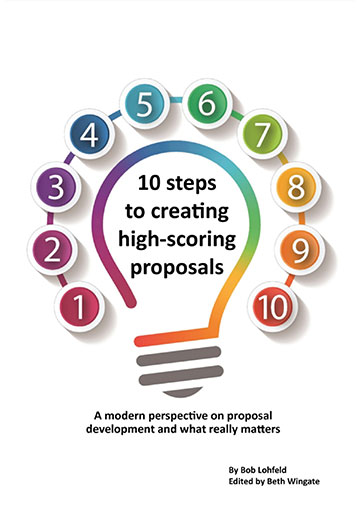How to Adapt Your Proposal Strategy for Executive Order Disruption

In 2025, the President’s Executive Orders (EOs) sent shockwaves through the federal procurement landscape. These EOs are not incremental policy adjustments; they represent a hard reset. With mandates to streamline acquisitions, reduce regulatory burdens, prioritize commercial solutions, and reevaluate long-standing diversity and compliance policies, these directives transform how the government buys and how industry must sell. In addition, the Federal Acquisition Regulation (FAR) 2.0 will likely come to fruition before the next fiscal year.
Bid and proposal professionals, beware: the days of lengthy development cycles, static proposal templates, and business-as-usual compliance checklists are changing. To win in this new environment, teams should quickly rethink how they plan, position, and produce proposals. Let’s break down the EOs that matter most and what your bid and proposal team can do to stay competitive.
Five Executive Orders Reshaping the Bid and Proposal Industry
1. EO 14275: Restoring Common Sense to Federal Procurement, Signed: April 15, 2025
- What it does: Directs a comprehensive rewrite of the FAR to eliminate burdensome requirements to occur within 180 days of the order.
- Why it matters to you: Expect the elimination of burdensome or duplicative compliance language that currently inflates page counts, review time, and bid cost. Proposal timelines may be shortened, forcing teams to become more agile in response to planning, pricing, and solutioning. Every agency must review and align its supplemental regulations to the new streamlined FAR. This will likely trigger a wave of updates to existing solicitations and templates across agencies, causing delays in request for proposal (RFP) releases. Proposal professionals must monitor updates to agency supplements.
- Your Move: Prepare for change by modernizing your writing strategy to align with a “less is more” FAR 2.0 environment. Collaborate closely with capture and legal teams to understand and track rule expirations or revisions.
2. EO 14271: Ensuring Commercial, Cost-Effective Solutions in Federal Contracts, Signed: April 15, 2025
- What it does: Mandates that federal agencies favor commercially available solutions over custom development whenever feasible.
- Why it matters to you: Gone are the days when technical complexity alone wins contracts. Agencies are now instructed to prioritize simplicity, cost-efficiency, and rapid deployment—ideals often found in commercial products and services.
- Your Move: Position your solution’s commercial viability in the executive summary and throughout the technical approach. Show how your offering saves time and money while reducing risk. Consider using charts showing market share, adoption by other federal agencies, or integration of commercial standards to make your point.
3. EO 14265: Modernizing Defense Acquisitions and Spurring Innovation in the Defense Industrial Base, Signed: April 9, 2025
- What it does: Declares the defense acquisition workforce a national strategic asset. It directs the Department of Defense (DOD) to expedite acquisitions, including a first preference for commercial solutions and a general preference for Other Transaction Authority (OTA), application of Rapid Capabilities Office (RCO) policies, or any other authorities or pathways to promote streamlined acquisitions under the Adaptive Acquisition Framework (AAF). Click here for a detailed analysis of the EO.
- Why it matters to you: Agencies are moving faster—and so must you. The government is leaning into non-traditional contracting methods, particularly for innovation-focused buys.
- Your Move: Prepare for compressed timelines and evolving proposal formats under OTA or RCOs. Emphasize low risk, rapid deployment, and operational value. Train your teams on how to structure proposals for speed and agility.
4. EO 14173: Ending Illegal Discrimination and Restoring Merit-Based Opportunity, Signed: January 21, 2025
- What it does: This EO marks a shift in how the federal government and its contractors approach compliance with civil rights laws, particularly regarding Diversity, Equity, Inclusion, and Accessibility (DEIA) programs. It repeals multiple longstanding executive orders, eliminates affirmative action requirements for federal contractors, and calls for streamlining federal contracting to eliminate DEI-related mandates.
- Why it matters to you: While the ethical and social conversation continues, this EO means some longstanding compliance narratives are no longer required—or may soon be removed from RFPs.
- Your Move: Review new RFPs for updated Equal Employment Opportunity (EEO), DEI, and labor compliance requirements. Align internal human resources and compliance with the language in the current FAR updates. Do not include DEI programs, staffing targets, or “balanced workforce” strategies unless specifically required by law (e.g., veteran preferences remain intact). Add clear language in relevant volumes (e.g., Staffing, Past Performance) emphasizing merit-based hiring, performance, and advancement.
5. EO 14268: Reforming Foreign Defense Sales to Improve Speed and Accountability, Signed: April 9, 2025
- What it does: Reduces bureaucracy in foreign military sales and encourages rapid contracting for allied defense support.
- Why it matters to you: If you’re a defense contractor working with international clients, timelines for foreign government opportunities will tighten, and responsiveness becomes a key differentiator.
- Your Move: Treat foreign defense sales like rapid response proposals, with streamlined narratives, clear value statements, and ready-to-go pricing. Ensure all international compliance and security protocols are documented and readily accessible.
Conclusion
These EOs present a clear federal pivot toward simplified acquisitions, commercial innovation, domestic sourcing, and faster outcomes. For proposal teams, the implications are profound:
✅ Less time to write
✅ More emphasis on cost, speed, and commercial value
✅ A need to align faster across technical, pricing, and operational teams
The procurement rules may change, but with the right strategy, you can still win—and win big. At Lohfeld Consulting, we are ready to help clients respond to these shifts. Click here to contact us.
Relevant Information
By Brenda Crist, Vice President at Lohfeld Consulting Group, MPA, CPP APMP Fellow
Lohfeld Consulting Group has proven results specializing in helping companies create winning captures and proposals. As the premier capture and proposal services consulting firm focused exclusively on government markets, we provide expert assistance to government contractors in Capture Planning and Strategy, Proposal Management and Writing, Capture and Proposal Process and Infrastructure, and Training. In the last 3 years, we’ve supported over 550 proposals winning more than $170B for our clients—including the Top 10 government contractors. Lohfeld Consulting Group is your “go-to” capture and proposal source! Start winning by contacting us at www.lohfeldconsulting.com and join us on LinkedIn, Facebook, and YouTube(TM).
Paperback or Kindle
10 steps to creating high-scoring proposals
by Bob Lohfeld
contributors Edited by Beth Wingate
Subscribe to our free ebrief
Teaming friends, frenemies, and enemies—12 tips to mitigate harmful effects
Did you know that contracting officers spend up to 20% of their time mitigating disputes between teaming partners? In an informal poll we conducted on LinkedIn last month, 40% of respondents classified their teaming partners as “frenemies” on their last bid.
Explore Further
- Advice (539)
- AI (28)
- APMP (18)
- Army MAPS Contracts (3)
- Business Development (294)
- Capture Management (266)
- Complex Technology Grants Services (26)
- Favorite Books (5)
- GenAI (4)
- Go-to-Market (27)
- Graphics (5)
- Lohfeld Books (2)
- NASA SEWP VI Contracts (2)
- Navy SeaPort-NxG Contracts (2)
- NIST MSE Grants (1)
- NIST NAPMP Grants (2)
- Past Performance (63)
- Post-submission Phase (14)
- Pre-RFP Preparation (264)
- Proposal Management (339)
- Proposal Production (75)
- Proposal Reviews (38)
- Proposal Writing (107)
- Pursuit Phase (108)
- Research Report (4)
- Resources (63)
- Tools & Tips (421)
- Training (13)
- Uncategorized (223)

Sign Up for INSIGHTS and Download your FREE book
We'd love to help you with your proposals. Enjoy our complimentary Lohfeld Consulting Group Capture & Proposal Insights & Tips book with your FREE subscription to our Insights Newsletter.
GET YOUR FREE BOOK



